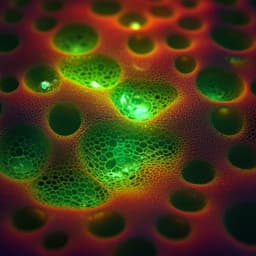
Engineering and Technology
Exploiting sulfonated covalent organic frameworks to fabricate long-lasting stability and chlorine-resistant thin-film nanocomposite nanofiltration membrane
W. Meng, Q. Xue, et al.
This innovative research by Wenqiao Meng, Qiang Xue, Jinyuan Zhu, and Kaisong Zhang demonstrates the synthesis of sulfonated covalent organic framework nanosheets, leading to improved nanofiltration membranes with exceptional water permeance and Na₂SO₄ rejection. Discover how these modifications enhance membrane performance and chlorine resistance!
~3 min • Beginner • English
Introduction
Nanofiltration (NF) membranes are key to low-energy desalination and removal of divalent ions, yet conventional thin-film composite (TFC) polyamide (PA) membranes face a permeance–selectivity trade-off and vulnerability to fouling and chlorine attack. Embedding nanofillers in the PA layer to create thin-film nanocomposite (TFN) membranes can add water transport channels and enhance hydrophilicity and charge, improving performance. However, many inorganic nanofillers agglomerate and are poorly compatible with PA, causing defects or densification. Two-dimensional covalent organic frameworks (COFs) offer organic compatibility, intrinsic nanopores, and tunable chemistry. Building on prior COF-based TFN advances, this study targets stronger hydrophilicity and electronegativity by using sulfonated COF nanosheets (S-CONs) bearing abundant –SO3H, –OH, and –NH2 groups. The research question is whether incorporating S-CONs into the PA layer via interfacial polymerization can simultaneously enhance water permeance, salt rejection, antifouling, long-term stability, and chlorine resistance compared with pristine TFC membranes. The study also probes structure–property mechanisms, including PA thickness, surface charge, crosslinking, and covalent bonding between S-CONs and PA.
Literature Review
Prior TFN strategies embedded nanomaterials such as zeolites, graphene oxide, MoS2, and carbon nanotubes to increase water channels and effective filtration area, breaking trade-offs and improving antifouling and chemical durability. For instance, MWCNTs enhanced hydrophilicity and negative surface charge and conferred chlorine resistance by protecting PA active sites; MoS2 nanosheets in hollow fiber TFN achieved high permeance and selectivity with improved electronegativity contributing to rejection and chlorine protection. COFs, as 2D porous organic materials with inherent nanopores and better chemical compatibility with PA, have enabled enhanced NF performance (e.g., COF SNW-1 in PA; CTN-COF in PA; TpPa-1 COF nanosheets in TFN with long-term stability). Functional group engineering (–COOH, –OH, –SO3H) on nanofillers further tunes membrane hydrophilicity and surface charge to improve Donnan exclusion and separation, and can influence PA crosslinking and stability. These works motivate using uniformly sulfonated COFs to synergistically improve TFN membrane hydrophilicity, charge, and stability, while mitigating agglomeration and compatibility issues.
Methodology
Synthesis of S-COFs and exfoliation to S-CONs: Sulfonated COFs (TpPa-SO3H) were synthesized solvothermally by reacting 2,4,6-triformylphloroglucinol (Tp) with 1,4-phenylenediamine-2-sulfonic acid (Pa-SO3H) in ethanol within a nitrogen-sealed PTFE-lined autoclave at 120 °C for 72 h. The product was washed sequentially with DMF and ethanol and vacuum-dried (60 °C, 12 h). S-COFs were mechanically ground with 1–2 drops of methanol for 0.5 h, dispersed in methanol, centrifuged (7000 rpm, 10 min), and dried (50 °C, 12 h) to obtain S-CONs nanosheets. Mechanical delamination increases aspect ratio without altering the crystal structure.
Characterization of S-CONs: Morphology by FE-SEM and TEM; elemental mapping by EDX; structure by ATR-FTIR and XPS; crystallinity by P-XRD; thickness by AFM; zeta potential (pH 2–10 in water) and lateral size in n-hexane by ZetaPALS. Reaction with TMC was probed by mixing S-CONs and TMC in n-hexane (stir 400 rpm, 30 min), washing, drying, then analyzing FT-IR (amide N–C=O at ~1633 cm⁻¹) and XPS (N1s components at ~397.8 eV for N–H and ~401.5 eV for N–C=O), evidencing covalent amide bond formation.
Membrane fabrication (TFC/TFN): Lab-made polysulfone (PSf) ultrafiltration supports (BSA rejection ~99%, PWP ~300 L·m⁻²·h⁻¹·bar⁻¹) were soaked in DI water and mounted on epoxy frames. Aqueous phase (DI water solvent) contained piperazine (PIP), DL-10-camphorsulfonic acid (CSA), triethylamine (TEA), and SDS. Organic phase was TMC in n-hexane. S-CONs were dispersed in the organic phase at 0–0.0100 g per 100 mL n-hexane. Interfacial polymerization: pour 50 mL aqueous phase onto substrate for 80 s, drain and air-dry; add 50 mL organic phase for 5 s; heat cure at 50 °C for 1 min; soak membranes in DI water at 4 °C. Membrane codes: M1 (0), M2 (0.004 g), M3 (0.006 g), M4 (0.007 g), M5 (0.009 g), M6 (0.0100 g) S-CONs loadings per 100 mL hexane.
Membrane characterization: Surface and cross-section by FE-SEM (Pt sputter-coated); PA layer thickness by TEM on ultramicrotomed epoxy-embedded samples; AFM roughness (5 × 5 µm); XPS for surface elemental composition and deconvolution (C1s, N1s, O1s) to estimate degree of network crosslinking (DNC) from amide vs carboxyl contents; P-XRD and EDX for additional surface analyses; LSCM to visualize fluorescent S-CONs distribution. Streaming potential (SurPASS 3) measured zeta potential using 10 mM KCl background and pH adjusted with 50 mM HCl/NaOH. Water contact angle (DSA100) measured at ≥10 random points per sample.
Performance testing: Dead-end NF apparatus at 25 ± 3 °C and 60–70% RH. Pre-compression for ≥30 min and 10 min pre-filtration; data collected via electronic balance to PC. Operating pressure 4.0 bar for all but pressure–flux tests. PWP and salt rejection measured with 2000 ppm salt solutions (Na2SO4, MgSO4, MgCl2, NaCl). PWP Pw = V/(A·t·ΔP); rejection R = (1 – Cp/Cf) × 100%. Pressure–flux linearity assessed from 1.0–5.0 bar (0.5 bar steps). Antifouling tests used cycles of BSA (1000 ppm, pH 6) filtration followed by DI water rinsing; normalized flux tracked across three cycles. Long-term stability with Na2SO4 (2000 ppm) over 51 days. Chlorine resistance tested at pH 5 and pH 10 under varying chlorine exposures; normalized flux and Na2SO4 rejection recorded. MD simulations estimated membrane free volume (Connolly surface, probe radius 0 Å) and water density profiles across the membrane.
Key Findings
- S-CONs structure and charge: Exfoliated S-CONs retained COF crystallinity (P-XRD) with lamellar morphology (SEM/TEM) and strong electronegativity (zeta potential −45.2 mV at pH 7), higher than bulk S-COFs (−40.7 mV). AFM thickness ~1.35–1.57 nm; lateral size ~458–1106 nm (avg ~578 nm).
- Covalent bonding: FT-IR (amide N–C=O at ~1633 cm⁻¹) and XPS N1s (N–H ~397.8 eV; N–C=O ~401.5 eV) confirmed S-CONs react with TMC to form amide bonds during IP, improving compatibility and stability.
- PA layer morphology: TEM showed S-CONs embedded in PA and reduced PA thickness from ~178–198 nm (M1) to ~100–128 nm (with S-CONs). AFM roughness increased with loading (TFC Ra 10.6 ± 0.5 nm; up to M6 Ra 26.6 ± 2.1 nm), increasing water–membrane contact area.
- Hydrophilicity and charge: Water contact angle decreased from 62.98 ± 3.94° (M1) to 45.14 ± 2.00° (M6, 0.009 g). Zeta potential at pH 7 became more negative: M1 −20.37 ± 2.22 mV; M3 −28.50 ± 2.27 mV; M6 −44.41 ± 1.26 mV. DNC increased with S-CONs addition (XPS deconvolution), sharpening pore size distribution.
- Free volume and pore size: MD-derived free volume increased from 38.07% (M1) to 39.08% (M3). PEG tests indicated effective pore diameter decreased from 0.38 nm (M1) to 0.36 nm (M3).
- Permeance and rejection: Optimal loading at 0.006 g (M3) yielded PWP 8.84 L·m⁻²·h⁻¹·bar⁻¹ (1.75× M1, 5.07 L·m⁻²·h⁻¹·bar⁻¹) with Na2SO4 rejection 98.97%. Permeance increased initially with loading then declined at higher loadings due to increased DNC (denser PA) and S-CONs aggregation blocking nanochannels. Salt rejection sequence followed Na2SO4 > MgSO4 > MgCl2 > NaCl. Enhanced Donnan exclusion and size exclusion from increased charge and crosslinking contributed to higher rejection.
- Mechanical/pressure response: Pressure–flux tests (1–5 bar) showed better linearity (higher compaction resistance) for M3 than M1.
- Antifouling: Under three BSA (1000 ppm) fouling/DI rinse cycles, normalized flux decreased to 0.68 (M1) vs 0.91 (M3); after first cycle 0.80 (M1) vs 0.96 (M3), indicating improved antifouling due to higher hydrophilicity and surface negativity.
- Long-term stability: Over 51 days (Na2SO4 2000 ppm), M1 flux and Na2SO4 rejection decreased by 27.7% and 2.6%, whereas M3 decreased by 13.9% and 0.94%, demonstrating superior operational stability from covalent anchoring of S-CONs and persistent charge effects.
- Chlorine resistance: At both pH 5 and pH 10, S-CONs-loaded membranes (M3, M6) exhibited smaller declines in normalized flux and Na2SO4 rejection than M1, with more severe degradation at pH 5 (HOCl dominant). Improved resistance attributed to formation of tertiary amide linkages reducing N–H sites for chlorination, enhanced intermolecular hydrogen bonding, and heightened surface electronegativity repelling active chlorine.
Discussion
The study demonstrates that sulfonated COF nanosheets effectively tune the PA selective layer at multiple scales to overcome the permeance–selectivity trade-off and improve durability. Incorporating S-CONs reduced PA thickness and increased roughness and free volume, providing additional water transport nanochannels while maintaining or improving selectivity through higher crosslinking and smaller effective pore size. Abundant –SO3H, –OH, and –NH2 groups increased surface hydrophilicity and negative charge, strengthening Donnan exclusion of multivalent anions and reducing protein adsorption, thereby enhancing both salt rejection and antifouling. Covalent reactions between S-CONs (secondary amide functionalities) and TMC created amide linkages that integrate the nanosheets within the PA matrix, promoting long-lasting stability under continuous operation and imparting chlorine resistance by decreasing susceptible N–H amide sites and fostering stronger hydrogen-bonded networks. Performance peaked at an optimal S-CONs loading (0.006 g per 100 mL hexane); higher loadings induced aggregation and densification, diminishing permeance and, at extremes, rejection. Overall, the findings validate functionalized 2D COFs as compatible, charged, porous nanofillers that can be embedded near the membrane surface to synergistically boost water transport, ion selectivity, fouling resistance, and chemical robustness relative to conventional TFC membranes.
Conclusion
Sulfonated COF nanosheets (S-CONs) were synthesized and integrated into the PA layer via interfacial polymerization to produce TFN NF membranes with improved separation performance and durability. At an optimal loading (0.006 g per 100 mL hexane), the membrane achieved PWP of 8.84 L·m⁻²·h⁻¹·bar⁻¹ (1.75× TFC) and Na2SO4 rejection of 98.97%. Enhancements stemmed from reduced PA thickness, increased hydrophilicity and surface electronegativity, slightly higher free volume, and stronger PA crosslinking. Covalent amide bonds between S-CONs and TMC improved compatibility, long-term stability, and chlorine resistance. This work highlights functionalized 2D COFs as potent nanofillers for high-performance, chlorine-resistant NF membranes.
Future work could optimize dispersion strategies to avoid aggregation at higher loadings, systematically tune S-CONs chemistry (e.g., varying densities of sulfonic and other functional groups), evaluate scalability and durability under crossflow and real wastewater conditions, broaden solute panels (organic micropollutants, hardness ions), and couple in situ spectroscopic/operando techniques with multiscale simulations to further resolve transport–structure relationships.
Limitations
- Aggregation at higher S-CONs loadings (≥0.009–0.010 g per 100 mL) reduced performance by blocking nanochannels and potentially introducing heterogeneity.
- Tests were conducted in a dead-end setup at lab scale; crossflow operation and real feed matrices were not assessed.
- Chlorine resistance was evaluated at two pH values and unspecified exposure intensities without exhaustive mechanistic quantification of degradation pathways.
- Long-term stability was demonstrated over 51 days; longer durations and cyclic chemical cleanings were not reported.
- MD simulations used idealized models (probe radius 0 Å) and provide qualitative trends rather than absolute pore volumes.
- Salt rejection focused on four inorganic salts at 2000 ppm; broader ion/species ranges and mixed-ion effects were not fully explored.
Related Publications
Explore these studies to deepen your understanding of the subject.







